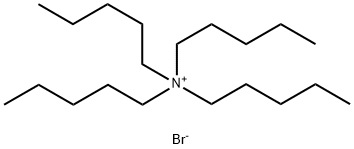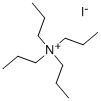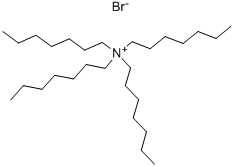TETRAPENTYLAMMONIUM BROMIDE
- CAS NO.:866-97-7
- Empirical Formula: C20H44BrN
- Molecular Weight: 378.48
- MDL number: MFCD00011856
- EINECS: 212-756-0
- SAFETY DATA SHEET (SDS)
- Update Date: 2025-01-27 09:38:02

What is TETRAPENTYLAMMONIUM BROMIDE?
Chemical properties
WHITE SHINY FLAKES
The Uses of TETRAPENTYLAMMONIUM BROMIDE
Tetrapentylammonium bromide can be used:
- As a versatile structure-directing agent for the synthesis of Zeolite-like heterobimetallic cyanide frameworks.
- As an alkylating agent for rhodium(I)-catalyzed alkylation reaction of benzylic amines and for N-alkylation of azaheterocycles.
- As a precursor to prepare a Cobalt-complex, {[(Pentyl)4N]3CoBr3}Cl2, which is used as a catalyst in the synthesis of multiwalled carbon nanotubes (MWCNTs).
Electrochemical synthesis of stable graphite intercalation compounds (GICs) containing tetrapentylammonium cations has been reported.
General Description
Tetrapentylammonium bromide is a quaternary ammonium salt with pentyl chains and a bromide counterion, which is generally used as a phase transfer catalyst.
Purification Methods
Crystallise it from pet ether, *benzene or acetone/ether mixtures and dry in vacuum at 40-50o for 2 days. It is used in ion-paired chromatography (Sagara et al. J Chromatogr 328 289 1985). [Beilstein 4 IV 677.]
Properties of TETRAPENTYLAMMONIUM BROMIDE
| Melting point: | 100-101 °C (lit.) |
| Density | 0.92333 g/cm3 (35.00℃) |
| refractive index | 1.5260 (estimate) |
| storage temp. | Inert atmosphere,Room Temperature |
| Water Solubility | Soluble in water |
| form | Shiny Flakes |
| color | White |
| PH | pH(10g/l, 25℃) : 5.0~7.0 |
| λmax | λ: 240 nm Amax: 0.04 λ: 250 nm Amax: 0.03 λ: 260 nm Amax: 0.02 λ: 500 nm Amax: 0.02 |
| BRN | 3658171 |
| EPA Substance Registry System | Tetrapentylammonium bromide (866-97-7) |
Safety information for TETRAPENTYLAMMONIUM BROMIDE
| Signal word | Warning |
| Pictogram(s) |
 Exclamation Mark Irritant GHS07 |
| GHS Hazard Statements |
H315:Skin corrosion/irritation H319:Serious eye damage/eye irritation H335:Specific target organ toxicity, single exposure;Respiratory tract irritation |
| Precautionary Statement Codes |
P261:Avoid breathing dust/fume/gas/mist/vapours/spray. P264:Wash hands thoroughly after handling. P264:Wash skin thouroughly after handling. P271:Use only outdoors or in a well-ventilated area. P280:Wear protective gloves/protective clothing/eye protection/face protection. P302+P352:IF ON SKIN: wash with plenty of soap and water. P305+P351+P338:IF IN EYES: Rinse cautiously with water for several minutes. Remove contact lenses, if present and easy to do. Continuerinsing. |
Computed Descriptors for TETRAPENTYLAMMONIUM BROMIDE
New Products
3-Iodophenylacetic acid 3-Pyridineacetonitrile, α-hydroxy- 2-Propanamine, 1-chloro-, hydrochloride (9CI) 3-(hexyloxy)-4-(pyridin-3-yl)-1,2,5-thiadiazole 2-Hexyn-1-ol Dibenzo-18-crown-6 Nickel(II) perchlorate hexahydrate, 98% 4-Bromophenylacetonitrile, 95% 3-Bromo-4-fluoroaniline, 97% Sodium tetraborate decahydrate, 98% Palladium(II) acetate, trimer, Pd 99% 4-Bromo-2-chlorotoluene, 97% N N Dimethylformamide Dimethyl Acetal (Dmf Dma) 2,3-Dichloro Benzoyl Cyanide [Side Chain] Bis(2-Chloroethyl) Amine Hydrochloride L-Glutamic Acid Diethyl Ester Hydrochloride 5-(Difluoromethoxy)-2-Mercaptobenzimidazole 1-Ethyl-3-(3-Dimethylaminopropyl)-Carbodiimide Hydrochloride [EDC Hcl] 1,4-Napthoquinone Bromoiodomethane Sodium Bicarbonate Methylene Dichloride (MDC) Ethyl Acetate Indole-3-Carbinol (I3C)Related products of tetrahydrofuran








You may like
-
 Tetraamylammonium Bromide CAS 866-97-7View Details
Tetraamylammonium Bromide CAS 866-97-7View Details
866-97-7 -
 Tetrapentylammonium bromide 95% CAS 866-97-7View Details
Tetrapentylammonium bromide 95% CAS 866-97-7View Details
866-97-7 -
 Tetrapentylammonium bromide CAS 866-97-7View Details
Tetrapentylammonium bromide CAS 866-97-7View Details
866-97-7 -
 Tetrapentylammonium bromide CAS 866-97-7View Details
Tetrapentylammonium bromide CAS 866-97-7View Details
866-97-7 -
 17604-74-9 3-Pyridineacetonitrile, α-hydroxy- 98+View Details
17604-74-9 3-Pyridineacetonitrile, α-hydroxy- 98+View Details
17604-74-9 -
 Cyclohexane, (2-propynyloxy)- 67967-07-1 98+View Details
Cyclohexane, (2-propynyloxy)- 67967-07-1 98+View Details
67967-07-1 -
 3-Iodophenylacetic acid 1878-69-9 98+View Details
3-Iodophenylacetic acid 1878-69-9 98+View Details
1878-69-9 -
 132945-75-6 (S)-1-Boc-3-methanesulfonyloxy-pyrrolidine 98+View Details
132945-75-6 (S)-1-Boc-3-methanesulfonyloxy-pyrrolidine 98+View Details
132945-75-6
Statement: All products displayed on this website are only used for non medical purposes such as industrial applications or scientific research, and cannot be used for clinical diagnosis or treatment of humans or animals. They are not medicinal or edible.
